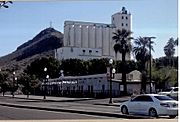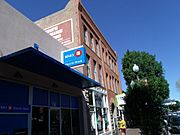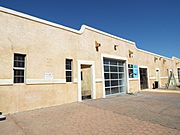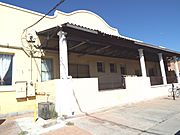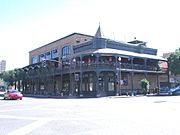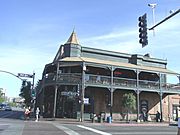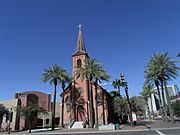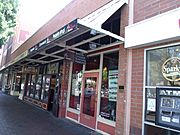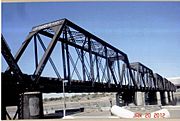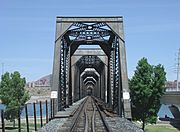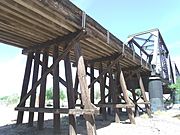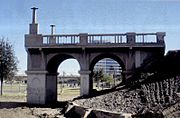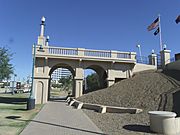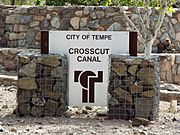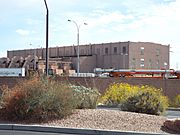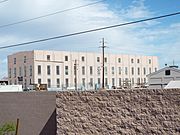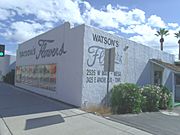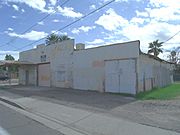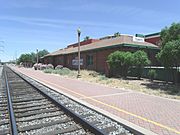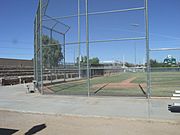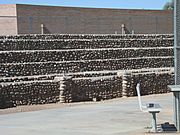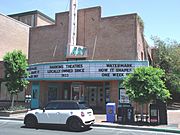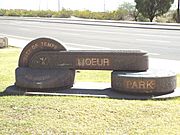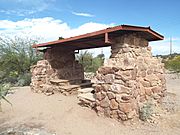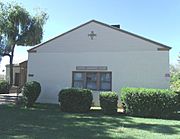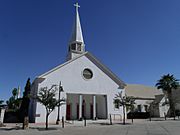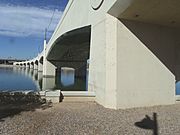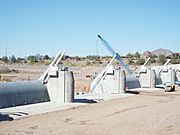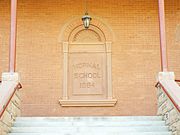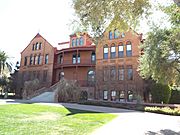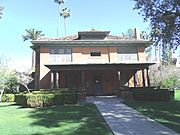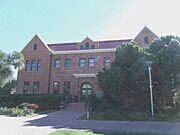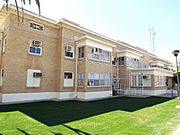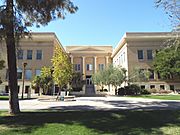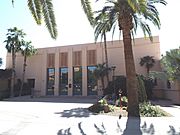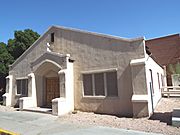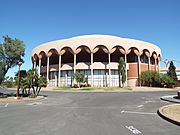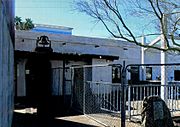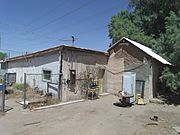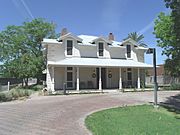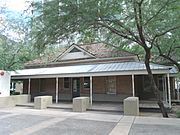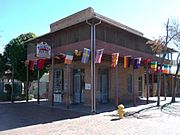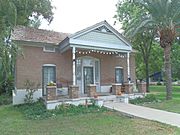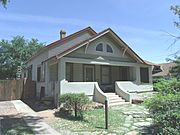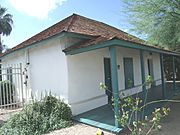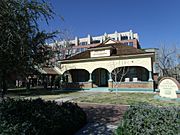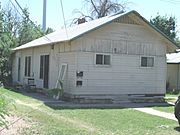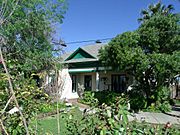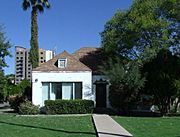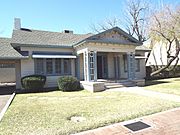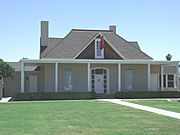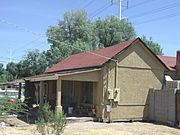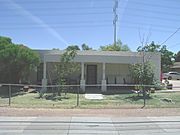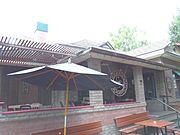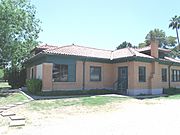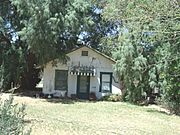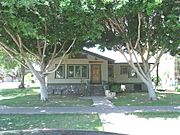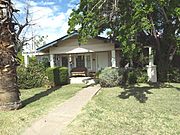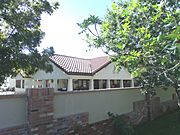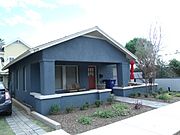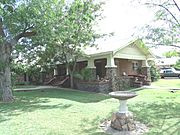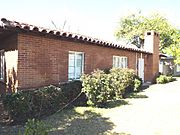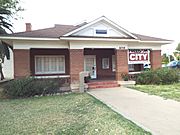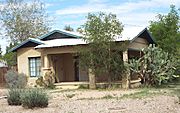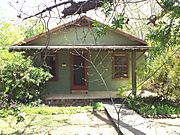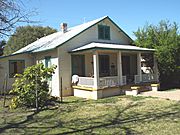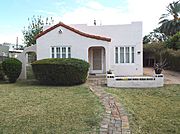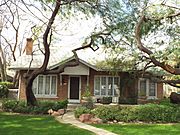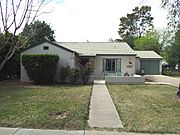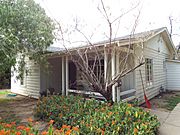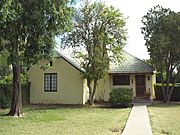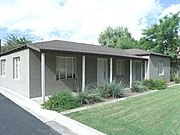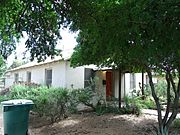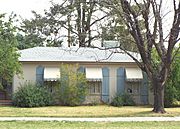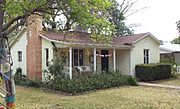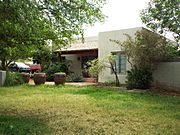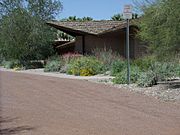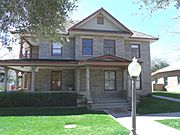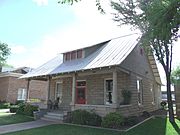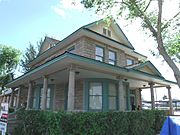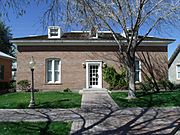List of historic properties in Tempe, Arizona facts for kids
Quick facts for kids
List of historic properties
in Tempe, Arizona |
|
|---|---|

Andre Building built in 1888
|
|

Location in Maricopa County and the state of Arizona
|
This article is a guide to some of the oldest and most important buildings and monuments in Tempe, Arizona. Tempe was once called Oidbaḍ by the Pima Native-American tribe. It was also known as Hayden's Ferry a long time ago. Today, it's a city in Maricopa County, Arizona.
Contents
Tempe's Story: A Quick Look
The land where Tempe is now was home to the Hohokam people between the years 750 and 1450. You can still see their ancient rock carvings, called petroglyphs, on the trails around "A" mountain. Later, the Salt River Pima-Maricopa Indian tribes lived here before settlers from the eastern United States arrived.
In 1865, the United States built a military base called Fort McDowell in what was then the "Arizona territory." This fort was near the Salt River. Because of this, a small farming community grew nearby, named "Hayden's Ferry." It was named after a ferry service run by Charles T. Hayden. Later, a pioneer named Darrell "Lord" Duppa thought the Salt River valley looked like the Vale of Tempe in Greece. So, the community's name was changed to "Tempe."
In 1885, Tempe was chosen as the location for the Territorial Normal School. This school grew over time and eventually became Arizona State University. In 1887, a railroad bridge was built across the Salt River in Tempe, connecting the town to the rest of the country. Tempe officially became a city in 1894.
Tempe has 45 places listed on the National Register of Historic Places. This list includes three historic neighborhoods. There are also many other important historical spots in the city that are part of the Tempe Historic Property Survey. For a property to stay on the National Register, it usually needs to be in its original spot. For example, the Josephine Frankenberg House and the Samuel C. Long House were moved. They are now in Tempe's Olde Towne Square, along with three other historic houses.
The Tempe Historic Preservation Office helps find and protect over 350 historic buildings in Tempe. However, they can't stop an owner from tearing down a historic building if they choose to. Sadly, some historic properties, like The R. J. Schweppe House and the Johnson/McLean House, have been torn down.
The Double Butte Cemetery was started in 1888 on land given by Niels Petersen. He was buried there until 1923, when his body was moved to his historic house property. The cemetery is now on the National Register of Historic Places. Many important people are buried here, including Charles Trumbull Hayden, who founded Tempe, and his son Carl T. Hayden, a very long-serving U.S. Senator. Also buried there are Benjamin Baker Moeur and John Howard Pyle, who both served as governors of Arizona.
Historic Places Needing Help
The Arizona Preservation Foundation helps find important historical places in Arizona that are in danger. In 2012, they said these places in Tempe were at risk:
- The Gonzales Martinez House.
- The Maple Ash Neighborhood
- People in Tempe are working hard to protect the Maple Ash neighborhood. It's the last neighborhood left from before World War II. Some want to keep its historic look, while others want to build new things because property values are going up.
Old Buildings, Bridges, and Churches
Here are some of Tempe's historic buildings, bridges, and places of worship. They are recognized as important by the National Register of Historic Places or the Tempe Historic Property Register.
- Hayden Flour Mill – Built in 1874 by Charles T. Hayden. This is why the street is called "Mill Avenue."
- Tempe Hardware Building – Built in 1875. It's at 520 S. Mill Ave.
- The Andre Building – Built in 1888 at 401-403 S. Mill Ave. It was originally a saddle and harness shop.
- The Borden Milk Company (also known as Creamery and Ice Factory) – Built in 1892 at 1300 E. 8th St. There are other buildings from the Borden Milk Company nearby at 1340, 1350, and 1360 E. 8th St.
- The historic Laird and Dines building – Built in 1893. This building was once a drug store. Both J. A. Dines and Hugh E. Laird, who were mayors of Tempe, used it as an unofficial City Hall.
- The Vienna Bakery Building – Built in 1893 at 415 S. Mill Avenue. It was updated in 1928. A German family ran a bakery here from 1904 to 1963.
- The St. Mary's Church – Our Lady of Mount Carmel Catholic Church – Built in 1903.
- The Goodwin Building – Built in 1907 at 514-518 S. Mill Ave. It's the last building in Tempe with a special cast-iron front. Garfield Abram Goodwin, who owned it, was also a mayor of Tempe.
- The Southern Pacific Railroad Bridge – This bridge over Tempe Lake was built in 1912.
- The Wooden Trestles of the 1912 Southern Pacific Bridge over Tempe Lake.
- Tempe National Bank Building – Built in 1912. Important people like Carl T. Hayden and Benjamin Baker Moeur were involved with this bank.
- Ruins of the Old 1913 Ash Avenue Bridge – This bridge was built for wagons and couldn't handle modern traffic. It was closed in 1931 and mostly torn down in 1991. A small part remains as a memorial.
- The Old 1913 Ash Avenue Bridge – as it looked in 2014. This part is now a memorial.
- Crosscut Canal Marker – Located in Moeur Park.
- The Crosscut Canal Power Plant – Built in 1914 at the northwest corner of Mill Ave. and Washington Ave.
- The E.M. White Dairy Barn – Built around 1919 at 1810 E. Apache Blvd. It's the only building left in Tempe made with river cobble stones.
- The Watson's Flowers Building – Built in 1920 at 2525 E. Apache Blvd. It's an example of adobe building in the Art Modern style.
- Marlatt's Garage – Built in 1922 at 1249 E. 8th St. It was first a garage owned by Clyde Gililland, who later became Tempe's mayor.
- The Tempe Train Depot – Built in 1924 at 3rd Street and Ash Avenue.
- The Tempe Beach Stadium – The baseball field was built in 1927, and the cobblestone wall around it was built in 1934. It's at the corner of 1st St. and Ash Ave.
- The Cobblestone – This "Wall" was built in 1934 around the Tempe Beach Stadium baseball field.
- Mill Ave. Bridge – Built in 1931.
- The College Theatre – Built in 1933 at 505-509 S. Mill Ave. Now called the Valley Art Theatre, it's Arizona's oldest movie theater that's still open.
- Entrance to Moeur Park – This park was created in 1933 on Mill Ave. It's named after Dr. Benjamin B. Moeur, a former Arizona governor. It was built as a rest stop for drivers.
- The Tempe Woman's Club – Built in 1936 at 1290 S. Mill Ave.
- The First Congregational Church – Built in 1948. This church has been an important landmark in Downtown Tempe since 1899.
- The New Mill Avenue Bridge – This bridge opened in 1994. It's one of two bridges crossing the Salt River in Tempe.
- Construction of the new Tempe Lake Dam in 2016.
- Historic buildings, bridges and houses of religious worship
(NRHP = National Register of Historic Places)
(THPR = Tempe Historic Property Register)
Arizona State University's Historic Buildings
Arizona State University (ASU) has several historic buildings on its campus. Here are some of them:
- Plaque in the main entrance of the Main Building, also known as Old Main and the Normal School.
- Main Building (or Old Main) – Built in 1894. It's on the ASU Campus and was the first building of the Territorial Normal School.
- President's House (or University Archives) – Built in 1900 on the ASU Campus.
- The Administration Building (or Building #206) – Built in 1900 on the ASU Campus.
- Matthews Hall (or Building #172) – Built in 1900 at 925 S. Forrest Mall on the ASU Campus.
- The Industrial Arts Building (now the School of Human Evolution and Social Change) – Built in 1914 at 900 Cady Mall on the ASU Campus.
- The B.B. Moeur Activity Building (or Building #207) – Built in 1925 at 201 Orange Mall on the ASU Campus.
- Tempe-The former sanctuary of First United Methodist Church – This church building was built around 1930 and is located in Forrest Mall on the ASU Campus.
- The Grady Gammage Memorial Auditorium – Built in 1950 at the corner of Mill and Apache Ave. It's a famous building on the ASU Campus.
Historic Houses
Here are some of the historic houses in Tempe:
- Charles T. Hayden House – Built in 1871 at 2000 1 W. Rio Salado Parkway. It's the oldest building in Tempe and was the home of Charles T. Hayden, Tempe's founder.
- The Gonzales-Martinez House – Built in 1880 at 320 W. First St. Ramon Gonzales worked for Charles T. Hayden.
- The Farmer-Goodwin House – Built in 1883 at 820 S. Farmer Ave. This adobe house is very well-preserved. Hiram Bradford Farmer, the first principal of the Territorial Normal School (ASU), bought it.
- The Brown-Strong House – Built in 1883 at 605 S. Ash Ave. Samuel Brown, a blacksmith, was once Tempe's mayor.
- Roy Hackett House – Built in 1888 at 401-405 W. 4th St. This is the oldest brick building in Tempe.
- The Sampson-Tupper House – Built in 1888 at 601 W. 3rd St. It was moved from its original spot to be saved.
- The Gage House – Built in 1888 at 115 W. University Dr. George Gage helped develop much of early Tempe.
- The Dines-Hight House – Built in 1889 at 508 W. Fifth St. It's connected to Tempe's original town layout.
- The Elias-Rodriguez House – Built in 1890 at 927 E. Eighth St. It's one of Tempe's oldest adobe houses and now a museum about local Mexican-American history.
- The Gov. Benjamin B. Moeur House – Built in 1892 at 34 E. 7th Street. This was the home of Dr. Benjamin B. Moeur, who was Tempe's only full-time doctor in 1896 and later served as Arizona's governor.
- The Niels Petersen House – Built in 1892 at 1414 W. Southern Ave. Niels Petersen was a Danish immigrant who became a successful rancher and banker in Tempe.
- The Spear House – Built in 1893 at 1015 S. Farmer Ave. Myron and Sylvia Spear, a Civil War veteran and a nurse, built this home.
- Harry Walker House – Built in 1903 at 118 E. 7th Street in a Neo-Colonial style.
- The Harrington-Birchett House – Built in 1895 at 202 E. 7th Street. Joseph T. Birchett, who lived here, was a mayor of Tempe.
- The C.P. Mullen House (also known as D. R. Van Petten House) – Built in 1900 at 918 Mill Ave.
- The Morrow-Hudson House – Built in 1904 at 1203 E. Alameda Drive. Estmer Hudson, who lived here, helped introduce Pima cotton to Arizona.
- The Hugh Laird House – Built in 1908 at 821 S. Farmer Ave. Hugh Laird was a pharmacist, postmaster, and served many years on the Tempe City Council, including as mayor.
- The Cummins House – Built in 1909 at 839 S. Farmer Ave. Aaron and Margaret Cummins built this house.
- The Chavez House – Built in 1910 at 927 S. Farmer Ave. Ramon and Nicolasa Chavez, who were ranch laborers, built this home.
- The W.A. Moeur House – Built in 1910 at 850 S. Ash Ave. W.A. Moeur helped organize Tempe's school system. This house is now a restaurant.
- The Carns- Buck House – Built in 1914 at 902 Farmer Ave. This was one of the first houses in the Goodwin Addition.
- The D.J. Frankenberg House – Built in 1915 at 2222 S. Price Road. Don Juan Frankenberg was a pioneer rancher who experimented with Pima cotton.
- The Judd House – Built in 1915 at 1208 S. Farmer Ave. Alfred and Ellen Bell first owned the farm where this house stands.
- The Byron Redden House – Built in 1918 at 948 S. Ash Ave. Byron Redden was a successful rancher and managed irrigation canals for 25 years.
- The Windes- Bell House – Built in 1920 at 24 9th Street. It's linked to Tempe attorney Dudley Windes and pioneer Ellen Bell.
- The Nichols House – Built in 1920 at 919 Maple Ave.
- The Lowell Redden House – Built in 1920 at 333 E. Carver St.
- The B.H. Scudder Rental House – Built in 1920 at 919 S. Maple Ave.
- The Scudder House – Built in 1929 at 959 S Ash Avenue. Benjamin Scudder, an educator, built several rental homes in the area.
- The Sidney B. Moeur House – Built in 1921 at 903 S. Ash Ave. Sidney was the son of W.A. Moeur and nephew of Governor Benjamin B. Moeur.
- The Selleh House – Built in 1925 at 1104 S. Mill Ave. Joseph "Joe" Selleh, who lived here, was a well-known athlete and coach at ASU.
- The Minson House – Built in 1925 at 1034 S. Mill Ave.
- The Elliot House – Built in 1925 at 1010 Maple Ave.
- The Guthrie House – Built in 1927 at 600 5th Street.
- The Blakely House – Built in 1927 at 305 S. Roosevelt Street.
- The McGinnes House – Built in 1928 at 915 Maple, Ave.
- The Hiatt House (also known as the Barnes House) – Built in 1928 at 1104 Ash Ave.
- The Harris House – Built in 1931 at 823 Maple Ave.
- The Lucier/O’Neill House – Built in 1933 at 1114 Maple Ave.
- The Butler (Gray) House – Built in 1934 at 1220 Mill Ave.
- The Bauer House – Built in 1934 at 599 5th Street.
- The Douglas-Gitlis House – Built in 1935 at 1206 Ash Ave.
- The Marriot House – Built in 1935 at 606 S. Roosevelt Street.
- The Baker House – Built in 1936 at 1029 Maple Ave.
- The Governor John Howard Pyle House – Built in 1938 at 1120 S. Ash Avenue. Pyle was the 9th Governor of Arizona.
- The Diefenderfer House – Built in 1939 at 1223 S Farmer Avenue by a retired couple.
- The Wexler House – Built in 1940 at 1215 Maple Ave.
- The Barnes House – Built in 1940 at 1203 Ash Ave.
- The Burket House – Built in 1945 at 501 5th Street.
- The Sandra Day O'Connor's House – Built in 1959. This house, belonging to the first female Supreme Court Justice, was moved to Tempe's Papago Park.
- Historic houses
(NRHP = National Register of Historic Places)
(THPR = Tempe Historic Property Register)
Olde Towne Square Houses
These houses were moved to "Olde Towne Square" to be preserved:
- The Josephine Frankenberg House – Built in 1910. Josephine Frankenberg was a nurse who helped people during the Great Influenza epidemic in 1918. She also rented rooms to teachers. The house was moved to 150 S. Ash Ave in 1992.
- The Samuel C. Long House – Built in 1910. This house was also moved to 150 S. Ash Ave in 1992.
- The Woolf-Cole House – Built in 1910. It was moved from its original spot to 150 S. Ash Ave in 1992.
- The Wolf-Sachs-Mrs. G.A. Goodwin House – Built in 1896. This house was also moved to 150 S. Ash Ave in 1992.
- The Newton/Warner House (Methodist Parsonage) – Built in 1910. It was moved to 150 S. Ash Ave in 1992.
- Historic Houses in "Olde Towne Square"
(NRHP = National Register of Historic Places)
(THPS = Tempe Historic Property Survey)
Images for kids
-
The grave site of Carl T. Hayden (1877–1972). Hayden was the first United States Senator to serve seven terms. He served as Arizona’s first representative for eight terms before entering the Senate, Hayden set the record for longest serving member of the United States Congress more than a decade before his retirement from politics. He is buried in sec. B-53
See also
- Double Butte Cemetery
- Tempe, Arizona
- National Register of Historic Places listings in Maricopa County, Arizona


